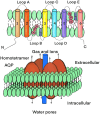Role of aquaporins in brain water transport and edema
- PMID: 39944892
- PMCID: PMC11814447
- DOI: 10.3389/fnins.2025.1518967
Role of aquaporins in brain water transport and edema
Abstract
Water serves as the primary substance in all living cells and is an essential molecule involved in numerous biological processes critical for maintaining homeostasis in the central nervous system (CNS). Disruptions in water balance can occur in conditions such as cerebral edema, where fluid accumulation results in increased intracranial pressure (ICP). Aquaporins (AQPs) are transmembrane proteins that play a vital role in the rapid transport of water across cell membranes. Various subtypes of AQPs (AQP1, AQP3, AQP4, AQP5, AQP6, AQP7, AQP8, AQP9, and AQP11) have been identified in brain tissue. This review summarizes the latest advancements in our understanding of the critical role of AQPs in regulating water transport in brain edema. Abundant evidence indicates that AQP4, the most prevalent AQP in the CNS, regulates brain water transport and contributes to both cytotoxic and vasogenic edema, suggesting that AQP4 may serve as a potential therapeutic target for brain edema. Additionally, some studies have indicated that AQP1 plays a significant role in the formation of cerebrospinal fluid (CSF) and the maintenance of steady-state ICP. However, to date, these findings have not been translated into clinical practice. There is an urgent need to develop specific AQP inhibitors and activators to explore the potential benefits of modulating the functions of AQP1 and AQP4 in the context of brain edema.
Keywords: aquaporins; brain edema; cytotoxic; hydrocephalus; vasogenic; water channels; water transport.
Copyright © 2025 Li, Wang, Huang, Zhang, Guan and Zhang.
Conflict of interest statement
The authors declare that the research was conducted in the absence of any commercial or financial relationships that could be construed as a potential conflict of interest.
Figures





Similar articles
-
Aquaporins in Nervous System.Adv Exp Med Biol. 2023;1398:99-124. doi: 10.1007/978-981-19-7415-1_7. Adv Exp Med Biol. 2023. PMID: 36717489
-
Aquaporins in Nervous System.Adv Exp Med Biol. 2017;969:81-103. doi: 10.1007/978-94-024-1057-0_5. Adv Exp Med Biol. 2017. PMID: 28258567 Review.
-
The Water Transport System in Astrocytes-Aquaporins.Cells. 2022 Aug 18;11(16):2564. doi: 10.3390/cells11162564. Cells. 2022. PMID: 36010640 Free PMC article. Review.
-
Aquaporins in sepsis- an update.Front Immunol. 2024 Oct 31;15:1495206. doi: 10.3389/fimmu.2024.1495206. eCollection 2024. Front Immunol. 2024. PMID: 39544938 Free PMC article. Review.
-
Relative CO(2)/NH(3) selectivities of mammalian aquaporins 0-9.Am J Physiol Cell Physiol. 2013 May 15;304(10):C985-94. doi: 10.1152/ajpcell.00033.2013. Epub 2013 Mar 13. Am J Physiol Cell Physiol. 2013. PMID: 23485707
Cited by
-
Glymphatic System Dysfunction in Elderly Patients with Late-Onset Epilepsy and Comorbid Chronic Insomnia Revealed by Diffusion Tensor Imaging Along the Perivascular Space (DTI-ALPS).Neuropsychiatr Dis Treat. 2025 Aug 4;21:1589-1598. doi: 10.2147/NDT.S510089. eCollection 2025. Neuropsychiatr Dis Treat. 2025. PMID: 40787617 Free PMC article.
-
Aquaporins in Acute Brain Injury: Insights from Clinical and Experimental Studies.Biomedicines. 2025 Jun 7;13(6):1406. doi: 10.3390/biomedicines13061406. Biomedicines. 2025. PMID: 40564125 Free PMC article. Review.
-
Aquaporins in the Capillaries of the Dura Mater of Pigs.Int J Mol Sci. 2025 Aug 7;26(15):7653. doi: 10.3390/ijms26157653. Int J Mol Sci. 2025. PMID: 40806781 Free PMC article.
References
Publication types
LinkOut - more resources
Full Text Sources

